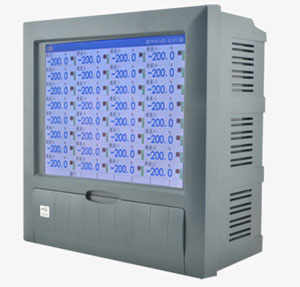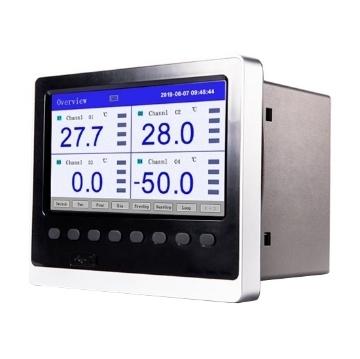The paperless recorder is an automated testing equipment that integrates measurement, display and recording functions. Its main function is to monitor various physical quantities in real time online, such as temperature, pressure, flow, voltage, etc., and digitize the data and then automatically record it.
Basic Knowledge
The paperless recorder records various input signals that need to be monitored and recorded at the industrial site, such as the flow signal of the flow meter, the pressure signal of the pressure transmitter, the temperature signal of the thermal resistor and thermocouple, etc., through a high-performance 32-bit ARM microcontroller. The processor performs data processing. On the one hand, it is displayed in various forms on the large-screen LCD screen. On the other hand, the data of these monitoring signals are stored in the large-capacity memory chip built in the machine so that it can be recorded in this recorder. Query and browse data and graphics directly on the instrument. Through the host computer management software, you can understand the instrument record information and print curves, graphics, and lists.
Classification

Color screen paperless recorder, blue screen paperless recorder, monochrome paperless recorder, medium and long chart paperless recorder, flow totalizing paperless recorder, among which the flow totalizing paperless recorder is one of the paperless recorders Expand applications.
Structural Features
- Flexible Host and HMI Structure: The system employs a flexible architecture that consists of a host unit with a full-color screen and an industrial-grade PC motherboard. The lower-level components are instrument-based.
- Multi-Channel Capability: A single data recorder can manage up to 64 channels, with the option for expansion to accommodate as many as 128 channels.
- Rich Graphical Interface: The system offers a diverse range of graphical displays, including real-time data, real-time graphs, alarm information, historical records, and report printing. It also allows for the creation of process flowcharts.
- Data Backup Options: Data can be conveniently backed up using USB drives, and an alternative backup method involves using RS485 communication to transfer data to other computers. The system can also automatically back up and display real-time data.
New Features
- USB Interface: The addition of a USB interface allows users to plug in a USB drive for backing up historical data and alarm information. It also enables the connection of a printer to produce historical graphs and data.
- Historical Data Management: Users can back up historical data onto a USB drive and then use the "Paperless Recorder USB Data Acquisition System" on a PC to view and analyze this data.

Instructions
- Instrument Coefficient Configuration: Before operating, it is essential to set the instrument coefficients. Ensure that the flowmeter is correctly connected and properly grounded before use.
- Regular Flowmeter Maintenance: Periodically clean, inspect, and recalibrate the flowmeter pipeline. For flowmeters with lubrication oil or cleaning fluid injection ports, follow the instructions in the manual to regularly inject lubrication oil or cleaning fluid to maintain the impeller's smooth operation.
- Monitor Instrument Status: Regularly check the condition of the display instrument and evaluate its readings. If any anomalies are detected, prompt investigation and correction are necessary.
- Filter Cleaning: The filter should be kept clean and free from impurities that could obstruct it. This can be assessed by observing an increased pressure gauge reading difference between the inlet and outlet. If clogging occurs, it should be promptly cleared; otherwise, it can significantly reduce flow rates.
- Calibration Equipment: To ensure the accuracy of the flowmeter, on-site calibration equipment should be available. The flowmeter must undergo regular calibration.
Applications of Paperless Recorders
- Industrial Process Control: Paperless recorders are extensively used in industries where continuous monitoring and control of variables are critical. This includes sectors like oil and gas, chemical manufacturing, and power generation.
- Pharmaceutical and Healthcare: In pharmaceutical manufacturing and healthcare facilities, precise data recording is crucial for quality control and regulatory compliance. Paperless recorders ensure accurate record-keeping in these sectors.
- Environmental Monitoring: Environmental agencies and organizations use paperless recorders for monitoring air quality, water quality, and meteorological data. These devices aid in tracking environmental trends and compliance with regulations.
- Laboratory Research: Scientific laboratories rely on paperless recorders to monitor and record experimental data with precision. This ensures that research findings are accurate and reproducible.
- Food and Beverage Industry: In food production and processing, paperless recorders are used to monitor temperature, humidity, and other critical parameters to ensure product quality and safety.
Paperless recorders have emerged as an indispensable technology in today's digital age. Their ability to provide real-time data access, accuracy, cost-efficiency, and versatile applications across various industries make them a valuable asset for businesses aiming to improve their data management processes. As technology continues to advance, we can expect paperless recorders to play an even more significant role in shaping the future of data capture and analysis. Various types of paperless recorders for sale at sisco to increase efficiency in your work.

